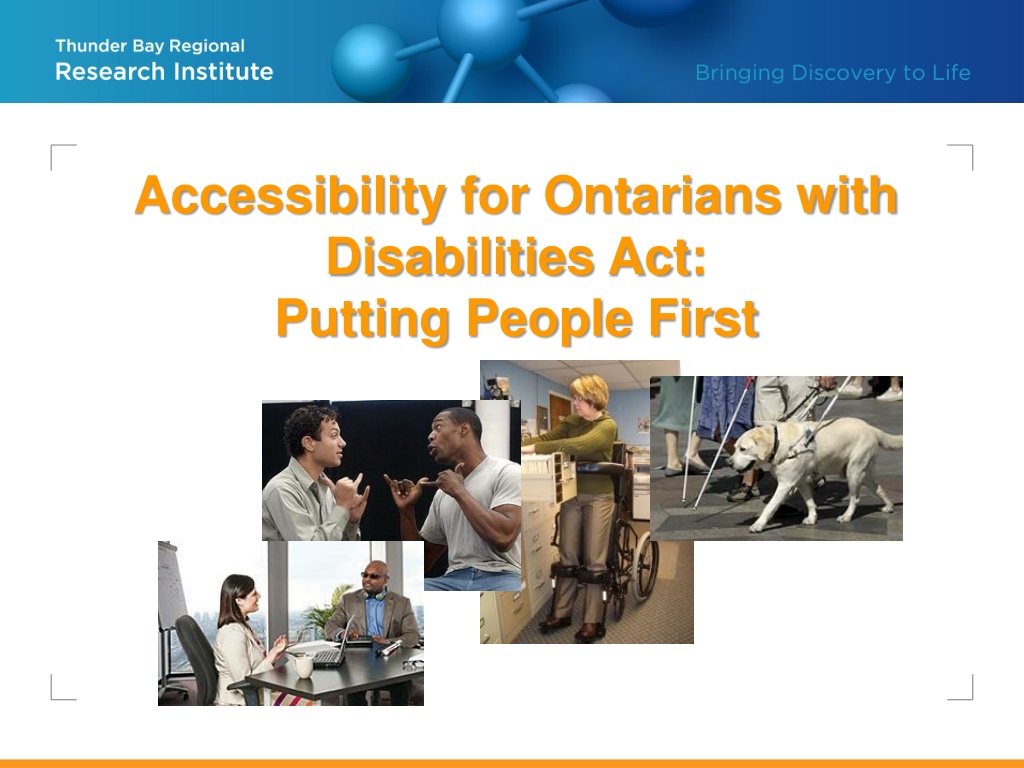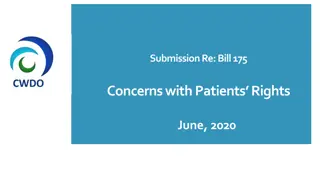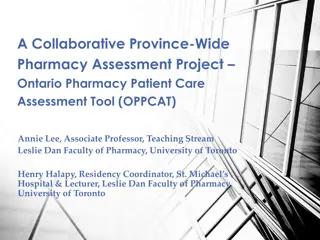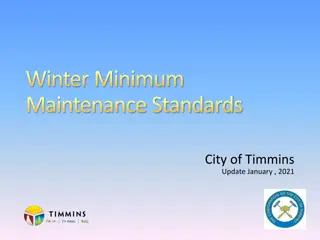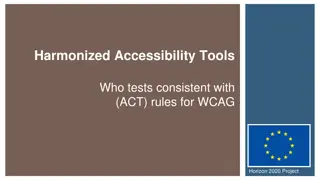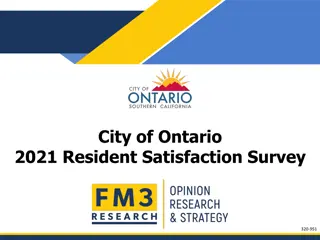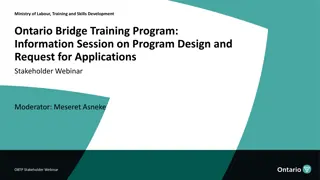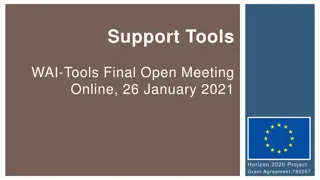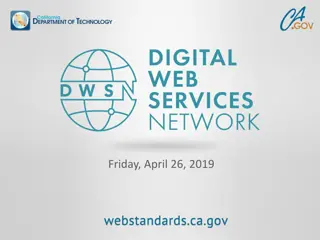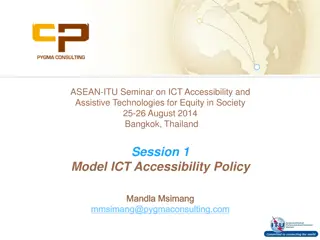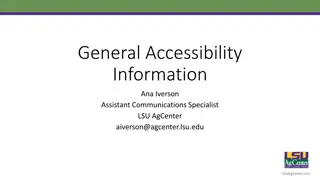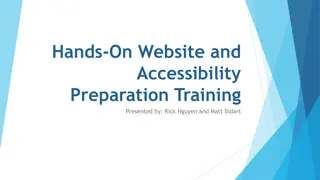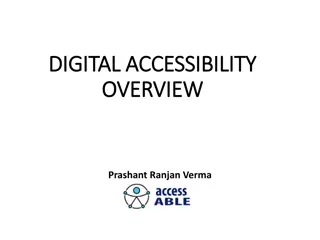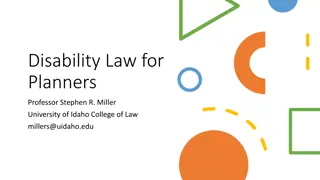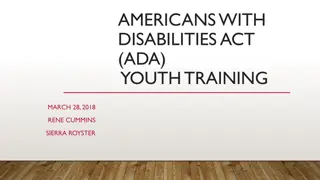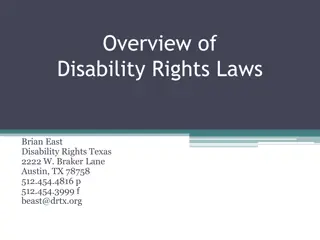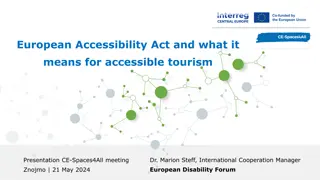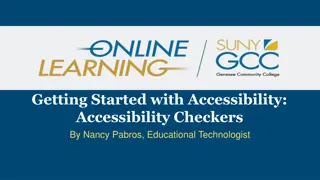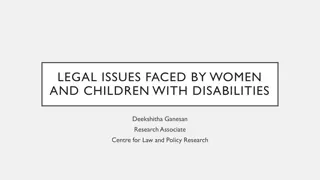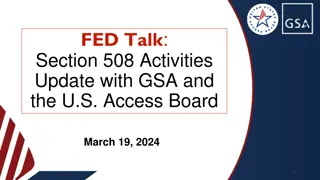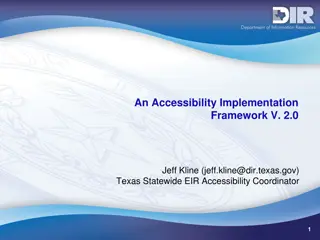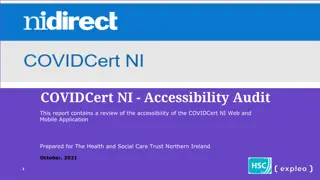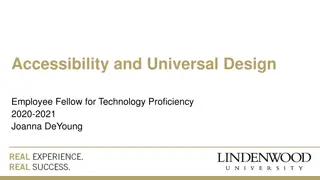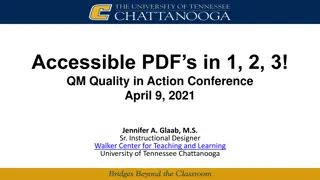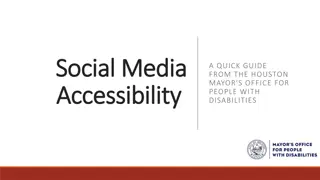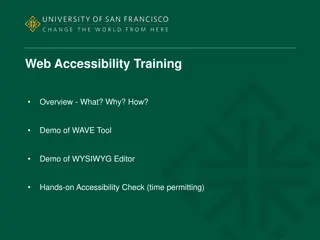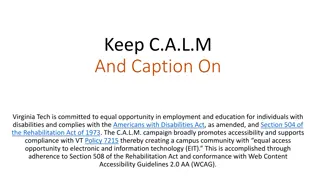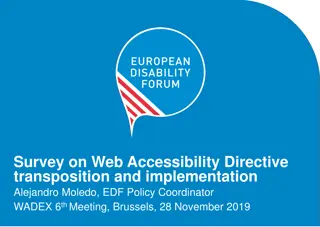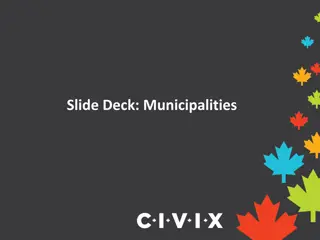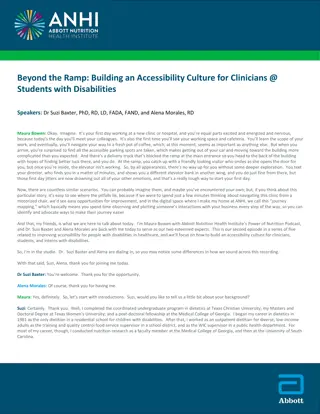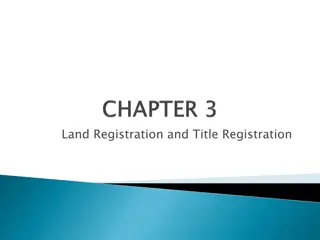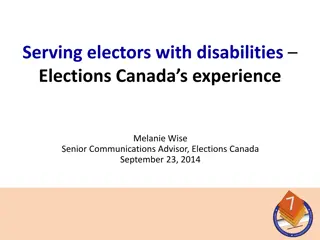Understanding the Ontario Accessibility for Ontarians with Disabilities Act (AODA)
The Accessibility for Ontarians with Disabilities Act (AODA) was enacted in 2005 with a goal to make Ontario accessible by 2025. It sets out mandatory standards in areas like customer service, employment, information, transportation, and public spaces. Disabilities can vary in severity and type, affecting one in seven Ontarians. Barriers to accessibility include attitudinal, informational, technological, and policy-related challenges. Physical disabilities impacting mobility, like wheelchair use, are highlighted, emphasizing the importance of inclusive design and accommodation.
Uploaded on Oct 03, 2024 | 0 Views
Download Presentation

Please find below an Image/Link to download the presentation.
The content on the website is provided AS IS for your information and personal use only. It may not be sold, licensed, or shared on other websites without obtaining consent from the author. Download presentation by click this link. If you encounter any issues during the download, it is possible that the publisher has removed the file from their server.
E N D
Presentation Transcript
Accessibility for Ontarians with Disabilities Act: Putting People First
What is the Accessibility for Ontarians with Disabilities Act? In 2005, the government enacted the Accessibility for Ontarians with Disabilities Act (AODA), which sets out a clear goal and timeframe to make Ontario accessible by 2025. The Act lays the framework for the development of province-wide mandatory standards on accessibility in all areas of daily life. Ontario now has accessibility standards in five areas: Customer service Employment Information and communications Transportation Design of public spaces You can learn more about these five areas at the Ministry of Economic Development, Employment & Infrastructure Please read TBRRI policy HR 2.15 Accessibility.
WHAT IS A DISABILITY? Any degree of physical disability, infirmity, malformation or disfigurement caused by bodily injury, birth defect or illness; A condition of mental impairment, or a developmental disability; A learning disability or a dysfunction in one or more of the processes involved in understanding or using symbols or spoken language; A mental disorder; or An injury or disability for which benefits were claimed or received under the insurance plan established under the Workplace Safety and Insurance Act, 1997; Disabilities can consist of different severity, visible as well as non-visible disabilities and disabilities of which the effects may come and go. It also includes sensory disabilities (e.g., hearing and vision), learning disabilities and physical disabilities; About one in seven Ontarians have a disability; Disability is one of 14 prohibited grounds recognized under the Ontario Human Rights Code.
WHAT IS A BARRIER TO ACCESSIBILITY? Accessibility is as much about anticipating and preventing barriers as it is about identifying and removing existing barriers. Often, if we design something with persons with disabilities in mind, we prevent barriers and help ensure better access. Some examples of such barriers include: Information/ communications: Print that is too small to read Assuming that a person who has a speech impairment cannot understand you Attitudinal: Technological: A website that does not support screen reading software A hiring process that does not offer accommodations in interviews Policy or practice:
PHYSICAL DISABILITES AFFECTING MOBILITY Accessibility Symbol This symbol indicates access for individuals with limited mobility, including wheelchair users ie. Accessible entrance, or washroom. There are many types and degrees of physical disabilities and not all require a wheelchair. It may be difficult to identify some people with a physical disability. They could be people with a heart or lung condition, arthritis, or another condition that affects their ability to walk, sit or stand. A person s mobility may be restricted in one or some of the following ways: Control or speed of movements Coordination and balance Ability to walk long distances Ability to sit or stand for prolonged periods of time
MENTAL HEALTH A health condition that changes a person s thinking, feelings, or behaviour (or all three) and that causes a person distress and difficulty in functioning. Features can include: Panic attacks, phobias Delusions, hallucinations Mood swings (depressive and manic episodes) Social withdrawal
INTELLECTUAL OR DEVELOPMENTAL Intellectual development and capacity that is below average This type of disability can mildly or profoundly limit ability to learn, communicate, do everyday activities and live independently May be an invisibly disability Remember people may understand more than you think SPEECH OR LANGUAGE May have problems communicating May have difficultly pronouncing words, slurring or stuttering May use communicationn boards, or other assistive devices
VISION LOSS SYMBOLS Access to Low Vision This symbol may be used to indicate access for people who are blind or have low vision. Accessible Print The symbol for large print is Large Print printed in size 18 font or larger. Braille Symbol This symbol indicates that printed matter is available in Braille.
HEARING LOSS SYMBOLS Assistive Listening Systems These systems transmit sound via hearing aids or headsets. Closed Captioning This symbol indicates that a television program or videotape is equipped to display dialogue for Deaf or hard of hearing persons. Volume Control Telephone This symbol indicates the location of telephones that have headsets with amplified sound and/or adjustable volume controls. Teletypewriter (TTY) This device is also known as a text telephone (TT), or telecommunications device for the Deaf . TTY indicates the presence of a device used with the telephone for communication with between Deaf, hard of hearing, speech impaired and/or hearing persons.
CULTURALLY DEAF The Deaf community is a sociological community of Deaf people who have been Deaf since birth. They consider themselves to be a cultural linguistic minority whose primary language is American Sign Language (ASL) or Langue des signes quebecois (LSQ), as opposed to individuals with a disability. Sign Language Interpretation This symbol indicates that Sign Language Interpretation is provided for lecture, tour, film, performance, or other program.
FOUR PRINCIPLES FOR PROVIDING SERVICE Dignity Providing service with dignity means the customer maintains his or her self- respect and the respect of other people. Dignified service means not treating persons with disabilities as an afterthought or forcing them to accept lesser service, quality or convenience. Independence Ensuring people are able to do things on their own without unnecessary help, or interference from others. Integration Integration means providing service in a way that allows the person with a disability to benefit from the same services, in the same place and in the same or similar way as other customers. Equal Opportunity Equal opportunity means having the same chances, options, benefits and results as others. In the case of services, it means that persons with disabilities have the same opportunity as others to benefit from the way you provide goods or services.
SERVICE ANIMALS & SERVICE PERSONS Think of a service animal as an animal with a job to do for a person with a disability (ie. guide dog). Remember that a service animal is not a pet, it is a working animal. Avoid touching or addressing service animals they are working and have to pay attention at all times. A support person is an individual hired or chosen to accompany a person with a disability to provide services or assistance with communication, mobility, personal care, medical needs or access to goods and services. A customer with a disability might not introduce their support person. If you are not sure which person is the customer, take your lead from the person using or requesting your goods and services, or simply ask. Once you have determined who your customer is, speak directly to them, not to their support person. For further information, please read TBRHSC Policy: ADMIN-15 Animals-Service
BEST PRACTICES Some best practices for communicating and interacting with anyone with a disability include: Address the person s service needs rather than focusing on the disability. Do not interrupt and finish people s sentences. Be patient - sometimes communicating with someone with a disability can take a bit longer, requiring you or the other person to repeat yourselves several times. Avoid touching or interacting with a service animal. Think of the assistive device as an extension of the person s personal space - touch these only if you are asked to. When you don t know what to do, it s always best to ask the person with a disability. Remember each individual may need a slightly different type of accommodation.
CULTURALLY DEAF: TIPS FOR COMMUNICATING Every effort will be made to establish effective communication and ensure equal access to our services for patients who use American Sign Language by providing professional sign language interpreters. People may use speech, sign language, lip reading, speech reading, reading and writing, or an interpreter to communicate If a person uses sign language it may actually be their first language, which means they may or may not be able to understand English or any other spoken language. Speak in a quiet area. Make sure you have the person s attention before beginning to speak. Do not over emphasize words and keep your hands away from your face.
ACCESSIBLE FORMATS AND COMMUNICATION SUPPORTS When requested, you must provide information and communications in an accessible manner to people with disabilities. Consult with the person to determine their accessibility needs. Alternatives to standard print are often referred to as accessible formats, and ways to help communication between people are referred to as communication supports. Accessible formats and communication supports must be provided in a timely manner and at a cost that is not more than the regular costs charged to other people. Examples of alternate formats and communication supports: Reading written information to a person directly Large print Text transcripts of audio or visual information Handwritten notes instead of spoken word An electronic document formatted to be accessible for use with a screen reader
ASSISTIVE DEVICES An assistive device is a tool, technology, or other mechanism that enables a person with a disability to do everyday tasks and activities such as moving, communicating, or lifting. It helps the person to maintain their independence at home, at work, and in the community. There are a variety of assistive devices. Many will be personal assistive devices, meaning they are owned and brought along by the individual, while others may be provided by the organization. Some examples are: Digital audio player Magnifier Hearing aid Teletypewriter (TTY) Wheelchair, walker, or cane Communication boards
INFORMING EMPLOYEES OF SUPPORTS Employers are required to inform all employees, both new and existing, of their accessible employment practices. This includes, but is not limited to, policies on providing job accommodations that take into account an employee s accessibility needs due to disability. This will make all employees aware of how the organization will support them if they have a disability or if they acquire a disability later in their career.
ACCESSIBLE FORMATS AND COMMUNICATION SUPPORTS UPON HIRE Employees may request accessible formats and communication supports and assistive devices. Employers must consult with employees to determine their accessibility needs and how best to accommodate them. Accessible formats and communication supports can be requested for: Information required for the employee to perform their job, and Information generally available to all employees
INDIVIDUAL ACCOMMODATION PLANS An individual accommodation plan is a formal way of recording and reviewing the workplace-related accommodations that will be provided to an employee with a disability. Employers must work with an employee with a disability to find the appropriate accommodation to meet the individual's accommodation needs. E.g. The need to provide screen reader software for a computer Employers must have a written process to document individual accommodation plans for employees with disabilities. This process occurs in conjunction with the staff, manager and Occupational Health & Safety Elements to Include in Individual Accommodation Plans: How the employee can participate in the process How the employer can seek outside expert advice to help determine an employee's accommodation needs How the privacy of personal information will be protected How often the plan will be reviewed For further information, please Read Policy: HR-cba-18: Accommodation Process of Disabled Employees
WORKPLACE EMERGENCY RESPONSE INFORMATION Individualized emergency response information can help both employees with disabilities and organizations be better prepared for a range of emergencies such as fire, power outages or severe weather. For example, an employee who cannot hear a fire alarm will need to know how and when to safely exit the building in the event of a fire. Every employer must provide individualized workplace emergency response information to employees with disabilities if: The disability makes it necessary, and The employer is aware of the need. With the employee's consent, you must ensure the information is shared with anyone designated to help them in an emergency. This information must be reviewed when: The employee moves to a different location in your organization. The employee's overall accommodation needs or plan are reviewed. You review your organization's emergency response policies. For further information, please Read Policy: ADMIN-27Accessibility Workplace Emergency Response
Procurement When purchasing from the goods/services/facility within the Scope of this Policy, the Programs/Departments must ensure they factor accessibility, and identify barriers, prior to the procurement being conducted. This Policy applies to goods/services/facility categories as listed below: Items/facilities that the public is in contact with that requires ergonomics i.e. hand dispensers, needle containers, service counters, waiting room furniture, etc. All construction and renovation work applicable to the building and grounds i.e. doors, entrances, elevators, washrooms, etc. Patient assisted devices i.e. beds, commodes, etc All visual or audio equipment i.e. signage, telephones, displays, etc. Exceptions: Programs/Departments purchasing through the Stores Department, or for goods and services already under existing contracts, are not required to factor in accessibility. The Purchasing Department will provide support and guidance in identifying accessibility needs and sourcing suitable products. For further information, please Read Policy: PUR-24 Accessibility Obligations in Procurement
QUESTION #1 Which of the following should you not do when serving a customer who uses an assistive device, a service animal, or a support person? a) b) Speak directly to the customer. Pet a guide dog because he s so cute and you love animals. Request permission to move your customer s wheelchair. Be aware of how to use specific assistive devices offered by your organization. c) d)
QUESTION #2 About one in seven Ontarians have a disability. a) True b) False
QUESTION #3 Choose the answer that best describes this common symbol: a) Printed material is available in Braille. b) Access for people with limited mobility. c) Access for people who are blind or have low vision. d) Enables people who are Deaf or hard of hearing a visual portion.
QUESTION #4 Choose the answer that best describes this common symbol: a) Devices that transmit sound via hearing aids or headsets. b) Printed material is available in Braille. c) Sign language interpretation is available. d) Access for individuals with limited mobility.
QUESTION #5 What are the four principles for providing service? a) Dignity, Independence, Integration, Equal Opportunity b) Dignity, Speaking Clearly, Integration, Equal Opportunity c) Diversity, Independence, Respect, Equal Opportunity d) Dignity, Independence, Integration, Respect
QUESTION #6 People who have disabilities are easily identified. a) True b) False
QUESTION #7 It is irrelevant if you identify the person or the disability first when you are speaking to or referring to someone who has a disability. Eg. Blind person vs. person with a vision impairment a) True b) False
QUESTION #8 In what instances must an employee's individualized workplace emergency response information be reviewed? Choose all that apply. a) During their yearly performance review. b) When you review your organization's emergency response policies. c) When the employee moves to a different location in your organization. d) At least every two years.
QUESTION #9 When requested, you must provide information and communications in an accessible manner to people with disabilities. a) True b) False
QUESTION #10 Which of the following statements are true in regards to accessible formats and communication supports: Employers must consult with employees to determine their accessibility needs and how best to accommodate them. Employees may request accessible formats and communication supports and assistive devices. Accessible formats and communication supports can be requested for: Information required for the employee to perform their job, and information generally available to all employees. All of the above. a) b) c) d)
QUESTION #11 Employers are required to notify all prospective applicants about their accessible employment practices. a) True b) False
QUESTION #12 Disability is not a prohibited ground under the Ontario Human Rights Code. a) True b) False
QUESTION #13 The Employer is required to have a documented Individual Accommodation plan for an employee with a disability. a) True b) False
QUESTION #14 An example of an Individualized Accommodation Plan for an employee with a disability is a) Providing computer screen reader software for a person with a hearing disability b) Providing an a large screen for a person with a vision impairment c) Providing an orthopedic chair for a person with a disability related to back or mobility d) All of the above
QUESTION #15 Policy PUR-24 Accessibility Obligations in Procurement applies to what goods/services/facility categories listed below ? a) Items/facilities that the public is in contact with that requires ergonomics i.e. hand dispensers, needle containers, service counters, waiting room furniture, etc. b) All construction and renovation work applicable to the building and grounds i.e. doors, entrances, elevators, washrooms, etc. c) Patient assisted devices i.e. beds, commodes, etc d) All visual or audio equipment i.e. signage, telephones, displays, etc. e) All of the above
TBRRI-AODA Training Sign off 2014 By acknowledging this form, I agree that I have read and understand the TBRRI s Accessibility for Ontarians with Disabilities Training (2014). ________________________ Signature __________________________ Date _________________________ Name (please print)
